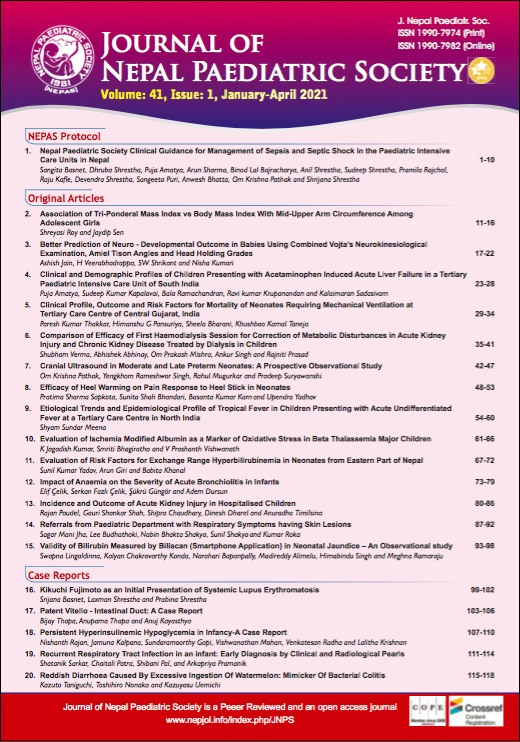Cranial Ultrasound in Moderate and Late Preterm Neonates: A Prospective Observational Study
DOI:
https://doi.org/10.3126/jnps.v41i1.31024Keywords:
Cranial ultrasound, late preterm, moderate pretermAbstract
Introduction: Preterm infants’ brain is vulnerable to ischemic and hemorrhagic injuries due to structural and molecular immaturities as well as associated co-morbidities, which is usually detected by bedside cranial ultrasound. Cranial ultrasound findings are common in preterm infants’ of < 32 weeks, so cranial ultrasound is routinely recommended in them but there is no such recommendation regarding moderate and late preterm infants. The objective of this study is to find the cranial ultrasound abnormalities in moderate and late preterm infants.
Methods: This prospective observational study was conducted in a tertiary level neonatal care unit. Hundred moderate and late preterm neonates delivered or admitted within seventh day of life were included in the study. Cranial ultrasound scan was performed between third and seventh day of life and before discharge and ultrasound findings were noted. Data were collected in predesigned case record form and analysed using Fischer Exact test.
Results: Out of 100 neonates, 47 (47%) were males and 53 (53%) females. There were 43 (43%) moderately preterm and 57 (57%) late preterm infants. Mean day of life for performing first and second cranial ultrasound was 4.17 (3 - 7) days and 13.24 (3 - 40) days respectively. Cranial abnormalities were noted in 26% neonates. Intra-ventricular haemorrhage grade 1 or 2 was the commonest abnormality noted. Choroid plexus cyst (4%), cerebral edema (3%), periventricular hyperechogenicity (3%) and hydrocephalus (1%) were the other abnormalities noted. Neonates having APGAR < 6 at one minute, mechanically ventilated and having co-morbidities had significantly higher incidence of abnormal findings.
Conclusions: It is reasonable to perform screening cranial ultrasound in high risk moderate and late preterm infants having low APGAR score, mechanically ventilated and having co-morbidities.
Downloads
Downloads
Published
How to Cite
Issue
Section
License
Authors who publish with this journal agree to the following terms:
Authors retain copyright and grant the journal right of first publication with the work simultaneously licensed under a Creative Commons Attribution License that allows others to share the work with an acknowledgement of the work's authorship and initial publication in this journal.
Authors are able to enter into separate, additional contractual arrangements for the non-exclusive distribution of the journal's published version of the work (e.g., post it to an institutional repository or publish it in a book), with an acknowledgement of its initial publication in this journal.
Authors are permitted and encouraged to post their work online (e.g., in institutional repositories or on their website) prior to and during the submission process, as it can lead to productive exchanges, as well as earlier and greater citation of published work (See The Effect of Open Access).



